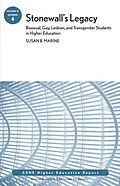Contemporary American colleges are increasingly queer places, wheresignificant steps toward inclusion of BGLT students have been made.Tracing the journey of BGLT students' emergence, which parallelsthe modern gay rights movement in America, this monograph providesan overview of data and theory derived from studying BGLT studentsand student movements in higher education. Offering context for theways that previously marginalized students in higher educationsurvive and thrive, this issue: * Tells the story of their growing visibility on campus * Summarizes collective knowledge to date about BGLT identitydevelopment * Takes stock of transgender students' distinctive position andexperiences in higher education * Assesses the role of the BGLT campus resource center insupporting students and advancing equity. This issue develops a picture of the ways that BGLT communityactivism informs scholarship (and vice versa). In the telling ofthe movement's stories, these lessons suggest a practice ofcollaborative transformation for advancing the future of BGLTequality in higher education. This is Volume 37 Issue 4 of the Jossey-Bass publicationASHE Higher Education Report. Each monograph is thedefinitive analysis of a tough higher education problem, based onthorough research and institutional experiences. Topics areidentified by a national survey. Noted practitioners and scholarsare then commissioned to write the reports, with experts providingcritical reviews of each manuscript before publication.
Autorentext
Susan B. Marine is the author of Stonewall's Legacy: Bisexual, Gay, Lesbian, and Transgender Students in Higher Education: AEHE, Volume 37, Number 4, published by Wiley.
Zusammenfassung
Contemporary American colleges are increasingly queer places, where significant steps toward inclusion of BGLT students have been made. Tracing the journey of BGLT students' emergence, which parallels the modern gay rights movement in America, this monograph provides an overview of data and theory derived from studying BGLT students and student movements in higher education. Offering context for the ways that previously marginalized students in higher education survive and thrive, this issue:
- Tells the story of their growing visibility on campus
- Summarizes collective knowledge to date about BGLT identity development
- Takes stock of transgender students' distinctive position and experiences in higher education
- Assesses the role of the BGLT campus resource center in supporting students and advancing equity.
This issue develops a picture of the ways that BGLT community activism informs scholarship (and vice versa). In the telling of the movement's stories, these lessons suggest a practice of collaborative transformation for advancing the future of BGLT equality in higher education.
This is Volume 37 Issue 4 of the Jossey-Bass publication ASHE Higher Education Report. Each monograph is the definitive analysis of a tough higher education problem, based on thorough research and institutional experiences. Topics are identified by a national survey. Noted practitioners and scholars are then commissioned to write the reports, with experts providing critical reviews of each manuscript before publication.
Inhalt
Executive Summary vii
Foreword xi
Acknowledgments xiii
Introduction and Overview 1
Who Are BGLT College Students? A Historical Overview 7
BGLT Student History Pre-Stonewall: What Do We Know? 9
Stonewall Approaches: BGLT Visibility and Marginality in the Twentieth Century 13
Stonewall and Its Aftermath: The Birth of the Homophile Movement 16
Transgender Lives and Stonewall 19
BGLT Rights on the College Campus: The Student Homophile Movement 20
Student Movement Snapshots: BGLT Student Activism at Three Institutions 23
Queer Student Activism Today 29
Conclusion: BGLT Student Visibility and Activism After Stonewall 33
Bisexual, Gay, and Lesbian Student Development Since Stonewall 35
Bisexual, Gay, and Lesbian Identity Development 37
Beyond the Monolithic Queer: Developmental Theory in Twenty-First-Century Context 47
Students of Color and Bisexual, Gay, and Lesbian Identity Development 49
Stonewall's Legacy v Intersectionality and Identity Development 51
Impediments to BGL Student Development in College 56
Conclusion 57
Transgender Student Issues and Development After Stonewall 59
Who Are Transgender College Students? 59
Transgender Students at Women's Colleges 62
Transgender Student Development 63
The Challenge of Transphobia on Campus 67
The Resilience of Transgender Students 72
Transgender Students217; Needs and Services 74
Conclusion 78
The BGLT Campus Resource Center 81
The First BGLT Campus Resource Centers: Their Founding and Purposes 82
BGLT Centers Today: Their Purposes and Roles 85
BGLT Students and Campus Climate Assessment 87
Center Leadership: A 220;New Profession221; in Higher Education 90
The Politics of BGLT Campus Resource Centers: Contested Territory 92
Higher Education Student Affairs and BGLT Issues 95
BGLT Issues in Professional Preparation of Student Affairs Practitioners 98
Conclusion 99
Identity and Solidarity: The Next Steps in BGLT Student Inclusion and Equity 101
Collaborative Transformation 103
Conclusion 109
References 113
Name Index 133
Subject Index 138
About the Author 145
